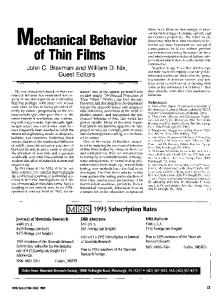Y-Doping Effects on the Dielectric Behavior of RF-Sputtered BST Thin Films
- PDF / 932,845 Bytes
- 6 Pages / 612 x 792 pts (letter) Page_size
- 20 Downloads / 389 Views
G1.7.1
Y-Doping Effects on the Dielectric Behavior of RF-Sputtered BST Thin Films
Ruey-Ven Wang* and Paul C. McIntyre Department of Materials Science and Engineering, Stanford University, CA, USA John D. Baniecki, Kenji Nomura, Takeshi Shioga, and Kazuaki Kurihara Fujitsu Laboratories, Atsugi, Japan * Currently in Argonne National Laboratory Abstract High dielectric constant, perovskite-structure materials, such as barium strontium titanate (BST), have been widely investigated for use in GHz LSI decoupling capacitor applications. In addition to modifying deposition process parameters, such as increasing deposition temperature, doping may be a viable way to increase permittivity and tunability in BST thin films without increasing the thermal budget. In this research, the effects of Y dopants on the dielectric behavior of RF-sputtered BST thin films have been systematically investigated. The BST thin films were deposited using ceramic targets with different compositions of yttrium oxide dopant. With Ydoping concentration of ~ 1.3 at.%, the permittivity at around zero electrical fields can be increased by more than 70% compared to nominally undoped BST thin films produced under the same deposition conditions. Based on x-ray diffraction strain analysis and inductively-coupled plasma composition measurements, the correlations among the dopant composition, BST film elastic strain and dielectric behavior have been systematically studied. Introduction High dielectric perovskite materials, such as Barium Strontium Titanate, are considered as the promising materials for the tunable microwave applications and memory devices. For these applications, a high capacitance density (>4 uF/cm2), low dielectric loss and low leakage currents are often required. A common method to increase capacitance density is to improve film crystallinality or increased grain size by increasing film deposition temperature. However, higher temperature processing often leads to unacceptably high leakage currents and dielectric loss. Moreover, high temperature processing may not be acceptable in some device applications such as development of low cost - low thermal budget substrates. Without increasing the thermal budget, doping may be a viable way to increase BST film permittity.[1] Of particular interest are the amphoteric dopants, such as Y, Ho Dy, etc., that can substitute at either the A-site or the B-site in the ABO3 perovskite lattice depending on the A/B site ratio. Y-dopants have been regarded as one of “magic dopants” in bulk ceramics; adding Y in barium titanate ceramics lowers the leakage currents and improves the resistance degradation. [2, 3] These improvements in bulk ceramics with Y doping has been attributed to the lowering of oxygen vacancy concentration or decrease in electron concentration depending on whether Y dopants substitute in A sites or B sites. [4,5] In this research, we studied the Y incorporation and its effects on the dielectric behavior of BST thin films. By incorporating Y into BST thin films, we found that the electri
Data Loading...











